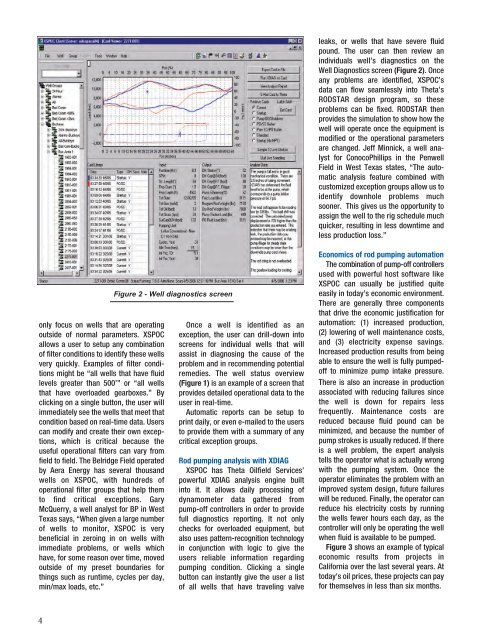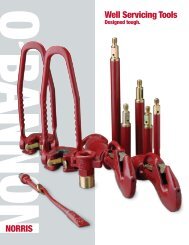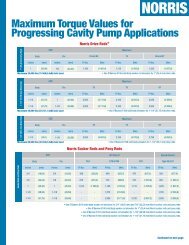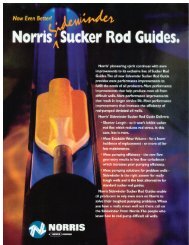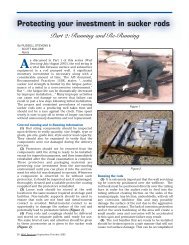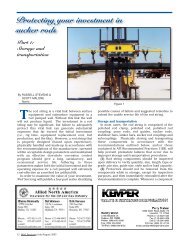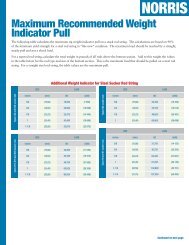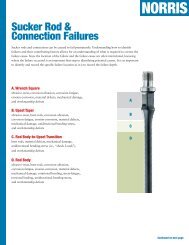xspoc spe - Norris Rods
xspoc spe - Norris Rods
xspoc spe - Norris Rods
You also want an ePaper? Increase the reach of your titles
YUMPU automatically turns print PDFs into web optimized ePapers that Google loves.
only focus on wells that are operating<br />
outside of normal parameters. XSPOC<br />
allows a user to setup any combination<br />
of filter conditions to identify these wells<br />
very quickly. Examples of filter conditions<br />
might be “all wells that have fluid<br />
levels greater than 500’” or “all wells<br />
that have overloaded gearboxes.” By<br />
clicking on a single button, the user will<br />
immediately see the wells that meet that<br />
condition based on real-time data. Users<br />
can modify and create their own exceptions,<br />
which is critical because the<br />
useful operational filters can vary from<br />
field to field. The Belridge Field operated<br />
by Aera Energy has several thousand<br />
wells on XSPOC, with hundreds of<br />
operational filter groups that help them<br />
to find critical exceptions. Gary<br />
McQuerry, a well analyst for BP in West<br />
Texas says, “When given a large number<br />
of wells to monitor, XSPOC is very<br />
beneficial in zeroing in on wells with<br />
immediate problems, or wells which<br />
have, for some reason over time, moved<br />
outside of my preset boundaries for<br />
things such as runtime, cycles per day,<br />
min/max loads, etc.”<br />
4<br />
Figure 2 - Well diagnostics screen<br />
Once a well is identified as an<br />
exception, the user can drill-down into<br />
screens for individual wells that will<br />
assist in diagnosing the cause of the<br />
problem and in recommending potential<br />
remedies. The well status overview<br />
(Figure 1) is an example of a screen that<br />
provides detailed operational data to the<br />
user in real-time.<br />
Automatic reports can be setup to<br />
print daily, or even e-mailed to the users<br />
to provide them with a summary of any<br />
critical exception groups.<br />
Rod pumping analysis with XDIAG<br />
XSPOC has Theta Oilfield Services’<br />
powerful XDIAG analysis engine built<br />
into it. It allows daily processing of<br />
dynamometer data gathered from<br />
pump-off controllers in order to provide<br />
full diagnostics reporting. It not only<br />
checks for overloaded equipment, but<br />
also uses pattern-recognition technology<br />
in conjunction with logic to give the<br />
users reliable information regarding<br />
pumping condition. Clicking a single<br />
button can instantly give the user a list<br />
of all wells that have traveling valve<br />
leaks, or wells that have severe fluid<br />
pound. The user can then review an<br />
individuals well’s diagnostics on the<br />
Well Diagnostics screen (Figure 2). Once<br />
any problems are identified, XSPOC’s<br />
data can flow seamlessly into Theta’s<br />
RODSTAR design program, so these<br />
problems can be fixed. RODSTAR then<br />
provides the simulation to show how the<br />
well will operate once the equipment is<br />
modified or the operational parameters<br />
are changed. Jeff Minnick, a well analyst<br />
for ConocoPhillips in the Penwell<br />
Field in West Texas states, “The automatic<br />
analysis feature combined with<br />
customized exception groups allow us to<br />
identify downhole problems much<br />
sooner. This gives us the opportunity to<br />
assign the well to the rig schedule much<br />
quicker, resulting in less downtime and<br />
less production loss.”<br />
Economics of rod pumping automation<br />
The combination of pump-off controllers<br />
used with powerful host software like<br />
XSPOC can usually be justified quite<br />
easily in today’s economic environment.<br />
There are generally three components<br />
that drive the economic justification for<br />
automation: (1) increased production,<br />
(2) lowering of well maintenance costs,<br />
and (3) electricity expense savings.<br />
Increased production results from being<br />
able to ensure the well is fully pumpedoff<br />
to minimize pump intake pressure.<br />
There is also an increase in production<br />
associated with reducing failures since<br />
the well is down for repairs less<br />
frequently. Maintenance costs are<br />
reduced because fluid pound can be<br />
minimized, and because the number of<br />
pump strokes is usually reduced. If there<br />
is a well problem, the expert analysis<br />
tells the operator what is actually wrong<br />
with the pumping system. Once the<br />
operator eliminates the problem with an<br />
improved system design, future failures<br />
will be reduced. Finally, the operator can<br />
reduce his electricity costs by running<br />
the wells fewer hours each day, as the<br />
controller will only be operating the well<br />
when fluid is available to be pumped.<br />
Figure 3 shows an example of typical<br />
economic results from projects in<br />
California over the last several years. At<br />
today's oil prices, these projects can pay<br />
for themselves in less than six months.


